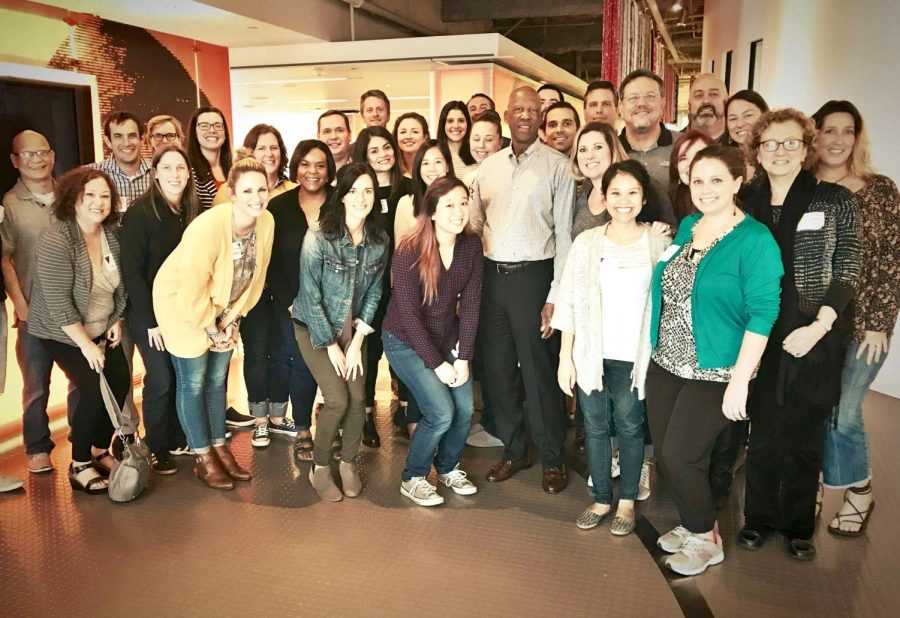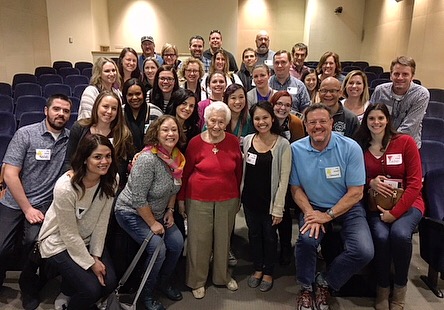CHS Staff Visits Museum of Tolerance
February 12, 2018
On the Thursday and Friday preceding Martin Luther King Jr. Day weekend, a total of 33 Cupertino High School staff members were absent. Contrary to popular belief, this vacancy was not a grand coincidence. Instead, teachers and administrators attended a grant-funded trip to the Museum of Tolerance, a multimedia exhibition in Los Angeles, Calif. that is designed to examine historical incidents of prejudice, such as the genocide of the Holocaust. It investigates how these events came to existence, who stood up and how our modern-day society can prevent similar predicaments in the future.
The administration scheduled the trip in response to a growing atmosphere of bias that teachers have been observing on campus. Already, the district staff has been consolidating advisory lessons produced by Teaching Tolerance, a project of the Southern Poverty Law Center that aims to bring light to identity-targeted bullying: acts of hatred based on religion, ethnicity and gender have all become prevalent in educational environments. Even though some cases may appear negligible, the administration aims to prevent further escalation of such incidents. Therefore, the Museum of Tolerance trip was imperative in giving staff members a chance to study similarities and patterns presented in the ugly parts of our past to better our present-day conditions.
According to chemistry teacher Colleen Carey, “a lot of the teachers were at a loss for how we could move forward, and this was just one step in [that direction].” The trip served as an agency for teachers to propel the school’s anti-bullying agenda.
Said Carey, “the goal was to eliminate these acts of hate which stem from people not having empathy for each other. How do you authentically have people build empathy for each other in a way that doesn’t feel forced? Because everybody has noticed that these advisory lessons—while we’re trying so hard, there’s almost always something that people are mocking.” Indeed, the constant ridicule of affirmative phrases promoted in advisory periods has watered down the meaning at which students are taking them.
English teacher Carley Stavis believes that the trip served as a reminder to the collective American society of “the many layers of our history—both positive and negative—that we can’t gloss over.” She adds that it is especially relevant to Silicon Valley as each of our unique cultural backgrounds and stories “can get lost in the shuffle of us being a very academically-driven school.” She hopes that this trip will allow teachers to embed a more human element into their classes amidst our rigorous and competitive environment. As a core teacher, Stavis appreciates “the luxury of teaching about a lot of these [historical implications] already,” but admits “she [needed] a reminder that the story piece matters so much.” In allowing teachers to recognize this issue, the trip pushes teachers to re-evaluate: “how do we bring that kind of stuff to the classroom that gets at the hearts of kids?”
When asked what she felt was the most impactful exhibition in the museum, Carey described a “wall with panels that had different time periods in American history. And there were different buttons that you could press so you could see what sort of diversity was there in America, what sort of hate was happening in America at that time, and who was standing up to that.” But she was surprised to see headlines that had only made the news within the past two weeks. Said Carey, “I thought at first that I was looking at stuff from the Civil Rights Movement in the 1960s—and it wasn’t. It was from January 2018.” The museum also featured speakers such as Terrence Roberts, a member of the Little Rock Nine, as well as various holocaust survivors. Said Carey, “hearing from people first-hand and just giving them the time and the room to share a story with us from their lives and to talk to them and try to understand their perspective and ask questions—that was so impactful.”
While the trip undoubtedly proved to be an impactful and emotional experience, it did not change many teachers’ set-in-stone perspectives. Instead, Carey credits the trip for “[reminding her] that small actions are also a way to build empathy and to help people relate to each other. It doesn’t always have to be this big grand thing where everybody in the entire school at once has an ‘Aha’ moment.” Stavis had a similar experience: “It was more reaffirming than anything, but it definitely impacted the way I’m thinking about my lesson planning and the curriculum and stuff we’re covering and the way we approach it. We’re not reinventing the wheel necessarily; we’re crafting and morphing stuff as an Equity Task Force into what we think is going to work best here based on what we know about our staff and our students and our parents.”
Carey was quick to implement what she learned in her chemistry classroom, despite the obstacle of jostling with emotions in an otherwise secular environment. “I feel like it’s not authentic in a science classroom to be like, ‘Let’s talk about our feelings’ and ‘How have you been belittled because of your race today?’ and ‘Okay now polar molecules…’ it just doesn’t flow as well.” By dedicating a block of time to check in with students every week, Carey feels that she has gotten to know her students and their struggles better on an individual level.
Despite the progress made in what students recently dubbed “Sharey with Carey,” the school as a whole still requires a lot of work. Nonetheless, Stavis believes that the trip has already achieved its goal to some extent. Said Stavis, “A big part of it was us as teachers, gaining some agency to feel like we know what things we should be doing on a practical level to try to better-address some of the needs of students that are more and more apparent in the current political climate.” Still, she admits that greater changes will require more time. “I think we’re all very aware we’re not at any sort of endpoint yet. I think it totally has served its purpose and will continue to well into the next however long.”





